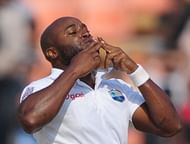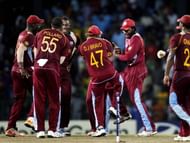Amid the fascination that the West Indies usually commands in various phases of history in its cricket, the past decade has added a sense of hurt and disappointment. The last couple of years, however, have been a little different. A competence based less on typical style and flourish but more on discipline and tenacity, the seeds of a tougher, smarter team in the near future, and an inertia that has limited the speed of progress have been the flavours of the side under Darren Sammy.
There have been many losses in the period, but they have shown some real fight as well which has enabled them to capture a world title and challenge the best of teams. There was a renewed interest in watching West Indies take the field, not always for the drama behind the end result but for the spice in battles within the war.
It has not been long since Sammy was appointed the captain. While the team performed better than expected in the 2011 World Cup under his captaincy, his first major assignment after taking over the team, it was not known then that it would be the start of a journey.
At the back of what seemed to be an inevitable defeat against South Africa in Delhi, Sammy spoke about having self-belief. “We’re just a win away. As long as we play to our potential, we can beat any team on that day.” They tried to translate thoughts into action and performed well against lower-ranked teams, the highlight being bowling Bangladesh out for 58 and getting their bus pelted by the local fans in Dhaka, while travelling in it after the game.
But they squandered winning positions in spectacular fashion, a habit that would haunt them for some time. Against England in the World Cup 2011, they lost four wickets for three runs to end up losing a game they had all but secured. Chasing 269 to win against India in their last group game, they were bowled out for 188 from being 157 for 3 at a stage.
Cricket Analyst and former West Indian fast bowler Ian Bishop reckoned it would take time for them to overturn their mental block. But despite this handicap, the team conjured some memorable battles in the months to come.
There were new members of the team who helped them do this, one of them being spinner Devendra Bishoo. He added quality spin to a decent seam attack, and the team secured their first Test win in more than two years, surprising Pakistan in Guyana. The win seemed like a flash in the pan as Pakistan won the next Test with ease, and India, devoid of some of their top stars, eked out a 1-0 win in the subsequent Test series.
The loss against India wasn’t too painful, though. The observations of India’s new coach Duncan Fletcher – cohesion in the side and a sense of purpose in the intense practice sessions – seemed to suggest a possible turnaround. Their batting was still shaky, but while on the field, they tried to make amends and show a greater spirit in not giving up.
Considering the difference in quality between the sides, the scoreline represented a mitigation of the expected hammering. There were lots of holes to be plugged, but there was a reassurance that efforts were being made to rectify this. Complacency, however, could lead them to consider the series result as being satisfactory, but once they tour India later that year, it would all come to light.
With the base being laid, the India tour proved fruitful. Resisting the Indian team cut out to dominate their opposition in dry, turning tracks has proved to be difficult for the best of teams. The decisive factor in the three otherwise evenly contested Tests was a collapse in batting at critical junctures; they were bowled out for 180 in the second innings in Delhi only to squander a 95-run first-innings lead, and for 153 in Kolkata in the first innings that cost them the game despite a determined resistance later.
Their fortitude almost bore fruit in Mumbai, where another batting collapse allowed both teams to anticipate victory. Eventually, neither team won, as the scores were level at the end of the scheduled time for the game, with India nine wickets down in the chase.
Darren Bravo, the young capable middle-order batsman, was their main contributor with the bat. He scored two centuries, one with an experienced Shivnarine Chanderpaul for company. This would prove to be a valuable pairing.
In April next year the two continued their productivity as Australia found it difficult to get the upper hand over their opposition. Chanderpaul, this time, outperformed everyone else by scoring 346 runs at 86.50, but it wasn’t enough to prevent the odd batting collapse which proved to be the difference between the two sides.
West Indies had held an upper hand in the first Test in Barbados with a solid batting performance in the first innings. But with some persistent bowling by Australia late into the fourth day, they were bowled out for 148. It proved decisive in the end as Australia only scraped through to a three-wicket victory.
The margin of defeat in the second and series-clinching win in Dominica was also not too big. When Chanderpaul and Bravo stood firm against the Australian bowlers putting together a solid partnership in the latter half of the fourth day, the stiff target of 370 seemed a realistic possibility. But an effort ball from Shane Watson surprised Bravo, who had been unruffled till then, to take his outside edge which brought the curtains down on the chase, falling short by 76 runs.
The difference in the attitude shift of West Indies and in the skill-sets of both teams was acknowledged by the former West Indian great Michael Holding.
The one takeaway for them was that they had been able to get themselves into winning positions in both the losses. One big catalyst for this was their new-ball bowler Kemar Roach. Moderately built in terms of height and physique for a fast bowler, Roach has the ability to move the ball both ways, use the landing crease to his advantage and bowl with a lot of pace. He accounted for 19 Australian wickets in the series.
But will Roach and the other seamers, who have so far had the option of falling back on the main spinner, rise up to the demands of cold and windy England?
They won’t. The superiority of the English in their conditions was hard to resist. Roach was the most productive bowler for the visitors with eight wickets, but he was far less prolific than seamers Stuart Broad and Tim Bresnan, who took 26 wickets between them.
A 155-run first-innings lead in the opening Test at Lord’s put paid to their hopes of saving the game, but a new ingredient in the rejuvenated West Indies team – fight and application – was on display when the home team had been set 191 to win.
A failure in batting again led to a comprehensive defeat in the second Test. But before the end of the tough series, some joy was found from an unlikely source. Tino Best, with his enthusiastic demeanour on the field, played the innings of his life to score a record 95 runs, the highest score by a No.11 in Tests.
There was a negative undercurrent, though, in his batting partner Denesh Ramdin’s written message, seen on a piece of paper revealed at the time of ‘celebration’ of his century, ‘Yeh Viv, talk nah’. It was an attack on Viv Richards for his perceived observations on the wicket-keeper.
Four months later, another written message from him was revealed after a momentous night in Sri Lanka which read ‘Sweeter from behind No.1’. West Indies had indeed beaten the rest of the world to be No.1; a special run that saw them winning the World T20 in Colombo. By this time, they had a bunch of power-packed short-format players in Chris Gayle, Kieran Pollard, Marlon Samuels and Sammy, who were capable big hitters; couple of quality all-rounders in Andre Russell and Dwayne Bravo; and in Sunil Narine, they had found a world-class spinner.
Narine’s eight wickets had earlier helped West Indies win a Test after a span nine months, when New Zealand were defeated in Antigua. He was seen as a replacement for Bishoo, who, after impressing initially, had fallen away. But Narine, too, couldn’t hold on to the Test spot. However, they finally found someone to fill the void in the form of lanky off-spinner Shane Shillingford, who managed to purchase more bounce than the other two.
The series win against New Zealand seemed effortless. Though the team, despite its attitude, had to undergo a string of defeats to make amends for years of rust and earn the change in luck.
That the luck would continue for some time was a foregone conclusion as they faced Bangladesh away and Zimbabwe at home after the successful World Twenty20 campaign.
A few tricky moments awaited them in the two Tests in Dhaka and Khulna, but this time they returned the favour by playing the game others had played on them all the while. Best helped them do this in one instance. His five-wicket burst on the final day, in a display of serious pace, helped them bowl Bangladesh out for 167 to clinch a crucial victory in a tough match by 77 runs.
Against Zimbabwe, they cruised their way to a 2-0 win. Shillingford single-handedly romped West Indies home by taking 19 wickets in what was his debut series. It was to be seen, however, whether the lack of testing opponents would affect them when they toured India again in a few months.
It did take a toll as India pulverised them to provide the outgoing Sachin Tendulkar an apt farewell in November last year. Those stinging losses made Sammy realise how far behind the top teams they really were, something that he admitted too.
To rub this in, they lost comprehensively to New Zealand, too, a month later. Bravo’s rearguard effort to score a double-century and rescue his team in Dunedin notwithstanding, it seemed the gap was larger than just being behind the ‘top teams’.
Their journey seems to have hit a roadblock since their less-than-expected showing in the Champions Trophy in June under their new one-day captain Dwayne Bravo. And there we halt, but not with a sense of cynicism for Sammy and his team.
There seems to be a message in this journey so far, and it is that West Indies’ domination in cricket is widely enjoyed; not just for their colourful style of playing a lazy-looking game but also for their humour on and off the field. Ian Chappell maintains cricket needs a strong West Indies and the past couple of years have given us a glimmer of hope of that happening.
Brand-new app in a brand-new avatar! Download CricRocket for fast cricket scores, rocket flicks, super notifications and much more! 🚀☄️


